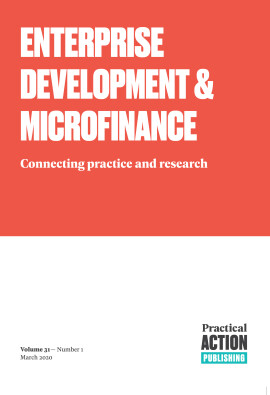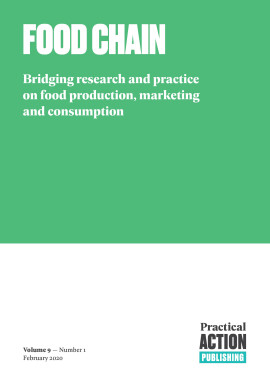The handpump choice is yours: a pilot study in Rumphi District, Malawi
Rochelle Holm | Alinafe Kamangira | Victor Kasulo | Prince Kaponda | Edwin Hara | Channing Carney-Filmore | Muthi Nhlema
In sub-Saharan Africa, moving towards the Sustainable Development Goals will require an approach to water and sanitation service delivery for many rural communities where handpumps still dominate infrastructure. This paper reviews a case study of allowing users (local government and communities) in Rumphi District, Malawi, to choose a handpump model based on information about the life-cycle costs. The results indicate that there is some awareness within communities and within the local government of several handpump options for the rural water supply in the study area. Given a choice of different handpump models in the treatment communities, each community chose the rope pump. Allowing communities to choose the type of handpump model, with input from both local government and donors on low cost borehole drilling, should be considered as an innovative approach to rural water service delivery.Alberts, J.H. (2004) ‘The rope pump: an example of technology transfer’, Waterlines 22(3): 22–5 <http://dx.doi.org/10.3362/0262-8104.2004.010>.
Alberts, H., Meza, R., Solis, D. and Rodriguez, M. (1993) ‘How the rope pump won in Nicaragua’, Waterlines 12(2): 3–5.
Chowns, E. (2015) ‘Is community management an efficient and effective model of public service delivery? Lessons from the rural water supply sector in Malawi’, Public Administration and Development 35(4): 263–76 <http://dx.doi.org/10.1002/pad.1737>.
Coloru, B., Mgaya, S. and Taubert, R.P. (2012) ‘Appropriate technologies for rural water supply: A comparative study between “rope pumps” and conventional piston-pumps on water quality and other sustainability parameters’, ACRA, Tanzania.
Foster, T. (2013) ‘Predictors of sustainability for community-managed handpumps in sub-Saharan Africa: evidence from Liberia, Sierra Leone, and Uganda’, Environmental Science and Technology 47: 12037–46 <http://dx.doi.org/10.1021/es402086n>.
Harvey, P.A. and Drouin, T. (2006) ‘The case for the rope-pump in Africa: a comparative performance analysis’, Journal of Water and Health 4(4): 499–510 <http://dx.doi.org/10.2166/wh.2006.032>.
Holm, R., Singini, W. and Gwayi, S. (2016) ‘Comparative evaluation of the cost of water in northern Malawi: from rural water wells to science education’, Applied Economics 48(47): 4573–83 <http://dx.doi.org/10.1080/00036846.2016.1161719>.
JICA (2016) JICA Project Brief Note: Federal Democratic Republic of Ethiopia Project for Rural Water Supply, Sanitation and Livelihood Improvement through Dissemination of Rope Pumps (RPs) for Drinking Water (WAS-RoPSS), Ethiopia: JICA.
Magoya, J. and Nhlema, M. (2016) ‘Capturing the consumer-voice: an evaluation of the social sustainability of water users associations in Malawi’, in 39th WEDC International Conference, 11–15 July 2016, Kumasi, Ghana.
Malawi Government (2009) Rumphi District Socio-Economic Profile, Rumphi District Assembly, Rumphi, Malawi.
Maltha, A. and Veldman, R. (2016) ‘A market-based approach to scale up sustainable rural water supply: experiences from Tanzania’, in 39th WEDC International Conference, 11–15 July 2016, Kumasi, Ghana.
Soublière, J. and Cloutier, C. (2015) ‘Explaining levels of local government involvement in service delivery: the dynamics of cross-sector partnerships in Malawi’, Public Administration and Development 35: 192–205 <http://dx.doi.org/10.1002/pad.1715>.
Sutton, S. and Gomme, J. (2009) ‘Transferring the rope pump to Africa: a long and winding road?’ Waterlines 28(2): 144–60 <http://dx.doi.org/10.3362/1756-3488.2009.015>.
United Nations (2016) The Sustainable Development Goals Report 2016, Department of Economic and Social Affairs (DESA), New York: United Nations <http://unstats.un.org/sdgs/report/2016/The%20Sustainable%20Development%20Goals%20Report%202016.pdf> [accessed 24 August 2016].
WHO/UNICEF (World Health Organization and UNICEF) (2015) Progress on Sanitation and Drinking Water: 2015 Update and MDG Assessment, Geneva: World Health Organization <www.unicef.org/publications/index_82419.html> [accessed 13 July 2015].
Alberts, J.H. (2004) ‘The rope pump: an example of technology transfer’, Waterlines 22(3): 22–5 <http://dx.doi.org/10.3362/0262-8104.2004.010>.
Alberts, H., Meza, R., Solis, D. and Rodriguez, M. (1993) ‘How the rope pump won in Nicaragua’, Waterlines 12(2): 3–5.
Chowns, E. (2015) ‘Is community management an efficient and effective model of public service delivery? Lessons from the rural water supply sector in Malawi’, Public Administration and Development 35(4): 263–76 <http://dx.doi.org/10.1002/pad.1737>.
Coloru, B., Mgaya, S. and Taubert, R.P. (2012) ‘Appropriate technologies for rural water supply: A comparative study between “rope pumps” and conventional piston-pumps on water quality and other sustainability parameters’, ACRA, Tanzania.
Foster, T. (2013) ‘Predictors of sustainability for community-managed handpumps in sub-Saharan Africa: evidence from Liberia, Sierra Leone, and Uganda’, Environmental Science and Technology 47: 12037–46 <http://dx.doi.org/10.1021/es402086n>.
Harvey, P.A. and Drouin, T. (2006) ‘The case for the rope-pump in Africa: a comparative performance analysis’, Journal of Water and Health 4(4): 499–510 <http://dx.doi.org/10.2166/wh.2006.032>.
Holm, R., Singini, W. and Gwayi, S. (2016) ‘Comparative evaluation of the cost of water in northern Malawi: from rural water wells to science education’, Applied Economics 48(47): 4573–83 <http://dx.doi.org/10.1080/00036846.2016.1161719>.
JICA (2016) JICA Project Brief Note: Federal Democratic Republic of Ethiopia Project for Rural Water Supply, Sanitation and Livelihood Improvement through Dissemination of Rope Pumps (RPs) for Drinking Water (WAS-RoPSS), Ethiopia: JICA.
Magoya, J. and Nhlema, M. (2016) ‘Capturing the consumer-voice: an evaluation of the social sustainability of water users associations in Malawi’, in 39th WEDC International Conference, 11–15 July 2016, Kumasi, Ghana.
Malawi Government (2009) Rumphi District Socio-Economic Profile, Rumphi District Assembly, Rumphi, Malawi.
Maltha, A. and Veldman, R. (2016) ‘A market-based approach to scale up sustainable rural water supply: experiences from Tanzania’, in 39th WEDC International Conference, 11–15 July 2016, Kumasi, Ghana.
Soublière, J. and Cloutier, C. (2015) ‘Explaining levels of local government involvement in service delivery: the dynamics of cross-sector partnerships in Malawi’, Public Administration and Development 35: 192–205 <http://dx.doi.org/10.1002/pad.1715>.
Sutton, S. and Gomme, J. (2009) ‘Transferring the rope pump to Africa: a long and winding road?’ Waterlines 28(2): 144–60 <http://dx.doi.org/10.3362/1756-3488.2009.015>.
United Nations (2016) The Sustainable Development Goals Report 2016, Department of Economic and Social Affairs (DESA), New York: United Nations <http://unstats.un.org/sdgs/report/2016/The%20Sustainable%20Development%20Goals%20Report%202016.pdf> [accessed 24 August 2016].
WHO/UNICEF (World Health Organization and UNICEF) (2015) Progress on Sanitation and Drinking Water: 2015 Update and MDG Assessment, Geneva: World Health Organization <www.unicef.org/publications/index_82419.html> [accessed 13 July 2015].
Alberts, J.H. (2004) ‘The rope pump: an example of technology transfer’, Waterlines 22(3): 22–5 <http://dx.doi.org/10.3362/0262-8104.2004.010>.
Alberts, H., Meza, R., Solis, D. and Rodriguez, M. (1993) ‘How the rope pump won in Nicaragua’, Waterlines 12(2): 3–5.
Chowns, E. (2015) ‘Is community management an efficient and effective model of public service delivery? Lessons from the rural water supply sector in Malawi’, Public Administration and Development 35(4): 263–76 <http://dx.doi.org/10.1002/pad.1737>.
Coloru, B., Mgaya, S. and Taubert, R.P. (2012) ‘Appropriate technologies for rural water supply: A comparative study between “rope pumps” and conventional piston-pumps on water quality and other sustainability parameters’, ACRA, Tanzania.
Foster, T. (2013) ‘Predictors of sustainability for community-managed handpumps in sub-Saharan Africa: evidence from Liberia, Sierra Leone, and Uganda’, Environmental Science and Technology 47: 12037–46 <http://dx.doi.org/10.1021/es402086n>.
Harvey, P.A. and Drouin, T. (2006) ‘The case for the rope-pump in Africa: a comparative performance analysis’, Journal of Water and Health 4(4): 499–510 <http://dx.doi.org/10.2166/wh.2006.032>.
Holm, R., Singini, W. and Gwayi, S. (2016) ‘Comparative evaluation of the cost of water in northern Malawi: from rural water wells to science education’, Applied Economics 48(47): 4573–83 <http://dx.doi.org/10.1080/00036846.2016.1161719>.
JICA (2016) JICA Project Brief Note: Federal Democratic Republic of Ethiopia Project for Rural Water Supply, Sanitation and Livelihood Improvement through Dissemination of Rope Pumps (RPs) for Drinking Water (WAS-RoPSS), Ethiopia: JICA.
Magoya, J. and Nhlema, M. (2016) ‘Capturing the consumer-voice: an evaluation of the social sustainability of water users associations in Malawi’, in 39th WEDC International Conference, 11–15 July 2016, Kumasi, Ghana.
Malawi Government (2009) Rumphi District Socio-Economic Profile, Rumphi District Assembly, Rumphi, Malawi.
Maltha, A. and Veldman, R. (2016) ‘A market-based approach to scale up sustainable rural water supply: experiences from Tanzania’, in 39th WEDC International Conference, 11–15 July 2016, Kumasi, Ghana.
Soublière, J. and Cloutier, C. (2015) ‘Explaining levels of local government involvement in service delivery: the dynamics of cross-sector partnerships in Malawi’, Public Administration and Development 35: 192–205 <http://dx.doi.org/10.1002/pad.1715>.
Sutton, S. and Gomme, J. (2009) ‘Transferring the rope pump to Africa: a long and winding road?’ Waterlines 28(2): 144–60 <http://dx.doi.org/10.3362/1756-3488.2009.015>.
United Nations (2016) The Sustainable Development Goals Report 2016, Department of Economic and Social Affairs (DESA), New York: United Nations <http://unstats.un.org/sdgs/report/2016/The%20Sustainable%20Development%20Goals%20Report%202016.pdf> [accessed 24 August 2016].
WHO/UNICEF (World Health Organization and UNICEF) (2015) Progress on Sanitation and Drinking Water: 2015 Update and MDG Assessment, Geneva: World Health Organization <www.unicef.org/publications/index_82419.html> [accessed 13 July 2015].
Alberts, J.H. (2004) ‘The rope pump: an example of technology transfer’, Waterlines 22(3): 22–5 <http://dx.doi.org/10.3362/0262-8104.2004.010>.
Alberts, H., Meza, R., Solis, D. and Rodriguez, M. (1993) ‘How the rope pump won in Nicaragua’, Waterlines 12(2): 3–5.
Chowns, E. (2015) ‘Is community management an efficient and effective model of public service delivery? Lessons from the rural water supply sector in Malawi’, Public Administration and Development 35(4): 263–76 <http://dx.doi.org/10.1002/pad.1737>.
Coloru, B., Mgaya, S. and Taubert, R.P. (2012) ‘Appropriate technologies for rural water supply: A comparative study between “rope pumps” and conventional piston-pumps on water quality and other sustainability parameters’, ACRA, Tanzania.
Foster, T. (2013) ‘Predictors of sustainability for community-managed handpumps in sub-Saharan Africa: evidence from Liberia, Sierra Leone, and Uganda’, Environmental Science and Technology 47: 12037–46 <http://dx.doi.org/10.1021/es402086n>.
Harvey, P.A. and Drouin, T. (2006) ‘The case for the rope-pump in Africa: a comparative performance analysis’, Journal of Water and Health 4(4): 499–510 <http://dx.doi.org/10.2166/wh.2006.032>.
Holm, R., Singini, W. and Gwayi, S. (2016) ‘Comparative evaluation of the cost of water in northern Malawi: from rural water wells to science education’, Applied Economics 48(47): 4573–83 <http://dx.doi.org/10.1080/00036846.2016.1161719>.
JICA (2016) JICA Project Brief Note: Federal Democratic Republic of Ethiopia Project for Rural Water Supply, Sanitation and Livelihood Improvement through Dissemination of Rope Pumps (RPs) for Drinking Water (WAS-RoPSS), Ethiopia: JICA.
Magoya, J. and Nhlema, M. (2016) ‘Capturing the consumer-voice: an evaluation of the social sustainability of water users associations in Malawi’, in 39th WEDC International Conference, 11–15 July 2016, Kumasi, Ghana.
Malawi Government (2009) Rumphi District Socio-Economic Profile, Rumphi District Assembly, Rumphi, Malawi.
Maltha, A. and Veldman, R. (2016) ‘A market-based approach to scale up sustainable rural water supply: experiences from Tanzania’, in 39th WEDC International Conference, 11–15 July 2016, Kumasi, Ghana.
Soublière, J. and Cloutier, C. (2015) ‘Explaining levels of local government involvement in service delivery: the dynamics of cross-sector partnerships in Malawi’, Public Administration and Development 35: 192–205 <http://dx.doi.org/10.1002/pad.1715>.
Sutton, S. and Gomme, J. (2009) ‘Transferring the rope pump to Africa: a long and winding road?’ Waterlines 28(2): 144–60 <http://dx.doi.org/10.3362/1756-3488.2009.015>.
United Nations (2016) The Sustainable Development Goals Report 2016, Department of Economic and Social Affairs (DESA), New York: United Nations <http://unstats.un.org/sdgs/report/2016/The%20Sustainable%20Development%20Goals%20Report%202016.pdf> [accessed 24 August 2016].
WHO/UNICEF (World Health Organization and UNICEF) (2015) Progress on Sanitation and Drinking Water: 2015 Update and MDG Assessment, Geneva: World Health Organization <www.unicef.org/publications/index_82419.html> [accessed 13 July 2015].
- Providing municipal faecal sludge management services: lessons from Bangladesh
- Webwatch
- A call to action: organizational, professional, and personal change for gender transformative WASH programming
- Menstrual hygiene management: education and empowerment for girls?
- WASH challenges to girls’ menstrual hygiene management in Metro Manila, Masbate, and South Central Mindanao, Philippines



